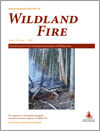International Journal of Wildland Fire
Volume 29
Number 1 2020
Scientists and land managers in Australia typically characterise savanna fires into small, low-intensity early dry season or large, high-intensity late dry season classes. Significant temporal and spatial variability exist in the relationship between fire size and fire weather and in the commencement and length of the late dry season in Australia’s savannas.
Using lasso-logistic regression, we developed three models of daily forest fire occurrence for British Columbia, Canada, that have strong predictive ability. Novel methods were used to address class imbalance and to rank variable importance. A cause-specific baseline risk variable was also introduced that was highly influential.
A framework for an expert-calibrated, risk-based spatially explicit wildland fire aerial detection demand index (ADDI) is presented. The ADDI incorporates factors influencing aerial detection patrol routeing such as potential fire occurrence and behaviour, and impacts on resources and assets while accounting for fires that may be reported by the public.
We assessed several fuel treatment scenarios designed by different spatial prioritisation algorithms to minimise risk to ecosystem services from wildland fire across our planning region. We modelled fuel treatment costs to understand how variability in costs and revenues across the district would influence outcomes. We found that treatment scenarios using cost data prevented greater losses and treated a greater area for the same budget. To conclude, we offer practical guidance for developing spatial information on treatment costs to support fuel treatment prioritisation efforts using ArcFuels and the Landscape Treatment Designer.
Masticated fuelbeds pose high fire hazards because, if they burn, the resultant fire intensities and durations are so high that many plants will be killed. We measured the rates of drying for 13 masticated fuelbeds and found most fuelbeds dried in less than 3 days. This information will aid in fire hazard prediction and prescribed fire management.
The development of the rate of spread is simulated when the fire is ignited by walking inward from the edges and compared with walking outward from the middle of the burn plot. The inward ignition is found to lead to large variation in the development of the rate of spread.
Measurements of fire rate of spread, energy release and residence time are presented for fires burning over beds of pine needles across a broad range of winds speeds up to 27 m s−1. Rate of spread was linearly related to wind speed, with a stronger dependence when winds exceeded 10 m s−1. Radiative and convective heating were also linearly dependent on wind speed whereas residence time was inversely proportional to wind speed.





